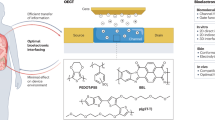Abstract
THE release of oxygen when a solution of haemoglobin is acidified is often referred to as the Bohr effect1,2. The phenomenon is a consequence of the difference between the titration curves of oxy and deoxyhaemoglobin. In physiological conditions, the acidification is caused by carbon dioxide entering the blood stream at the muscle tissue, and there may be further specific reaction of the carbon dioxide with the haemoglobin3. The observations presented here deal with the titration curve of haemoglobin in the absence of carbon dioxide, and were obtained as part of an effort to interpret Kerr effect data on haemoglobin4.
This is a preview of subscription content, access via your institution
Access options
Subscribe to this journal
Receive 51 print issues and online access
$199.00 per year
only $3.90 per issue
Buy this article
- Purchase on Springer Link
- Instant access to full article PDF
Prices may be subject to local taxes which are calculated during checkout
Similar content being viewed by others
References
Wyman, J., Adv. Protein Chem., 4, 458 (1948).
Rossi-Fanelli, A., Antonini, E., and Caputo, A., Adv. Protein Chem., 19, 74 (1964).
Rossi-Bernardi, L., and Roughton, F. J. W., J. Physiol., 189, 1 (1967).
Orttung, W. H., J. Amer. Chem. Soc., 87, 924 (1965).
Tanford, C., and Kirkwood, J. G., J. Amer. Chem. Soc., 79, 5333 (1957).
Orttung, W. H., J. Phys. Chem. (in the press).
Orttung, W. H., J. Amer. Chem. Soc. (in the press).
Perutz, M. F., J. Mol. Biol., 13, 646 (1965).
Atlas of Protein Sequence and Structure 1967–68 (edit. by Dayhoff, M. O., and Eck, R. V.) (The National Biomedical Research Foundation, Silver Spring, Maryland, 1968).
Cohn, E. J., Green, A. A., and Blanchard, M. H., J. Amer. Chem. Soc., 59, 509 (1937).
Perutz, M. F., Muirhead, H., Cox, J. M., and Goaman, L. C. G., Nature, 219, 131 (1968).
Muirhead, H., Cox, J. M., Mazzarella, L., and Perutz, M. F., J. Mol. Biol., 28, 117 (1967).
German, B., and Wyman, J., J. Biol. Chem., 117, 533 (1937).
Antonini, E., Wyman, J., Brunori, M., Fronticelli, C., Bucci, E., and Rossi-Fanelli, A., J. Biol. Chem., 240, 1096 (1965).
Nobbs, C. L., Watson, H. C., and Kendrew, J. C., Nature, 209, 339 (1966).
Hill, R. J., and Davis, R. W., J. Biol. Chem., 242, 2005 (1967).
Author information
Authors and Affiliations
Rights and permissions
About this article
Cite this article
ORTTUNG, W. Plausible Interpretation of the Bohr Effect in Haemoglobin. Nature 220, 1122–1124 (1968). https://doi.org/10.1038/2201122a0
Received:
Issue Date:
DOI: https://doi.org/10.1038/2201122a0
Comments
By submitting a comment you agree to abide by our Terms and Community Guidelines. If you find something abusive or that does not comply with our terms or guidelines please flag it as inappropriate.



